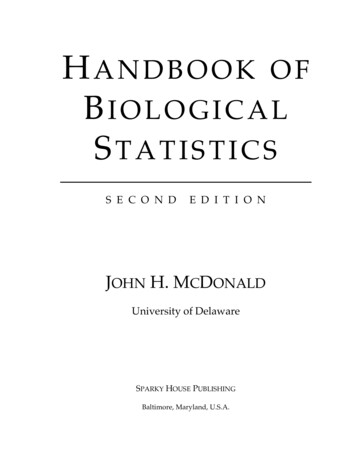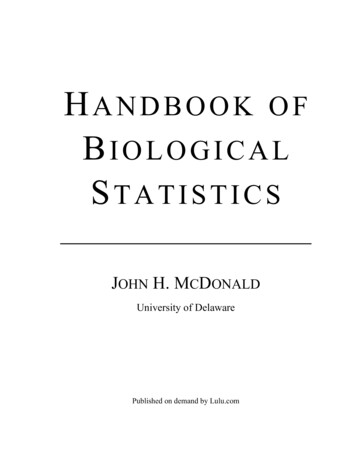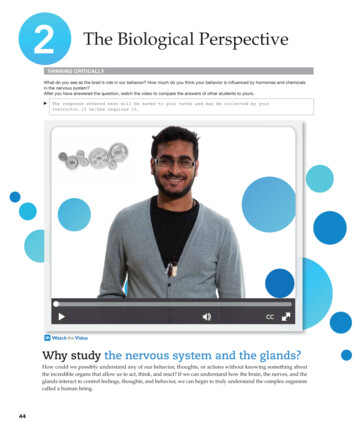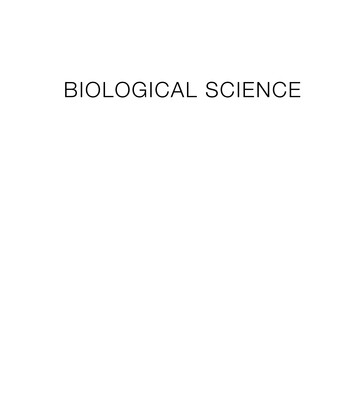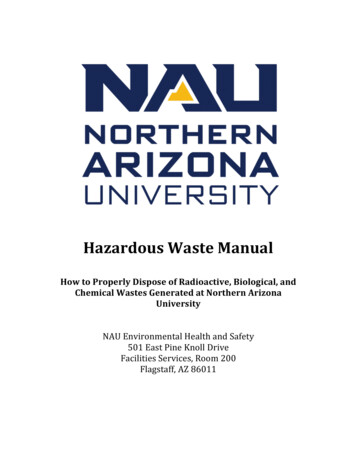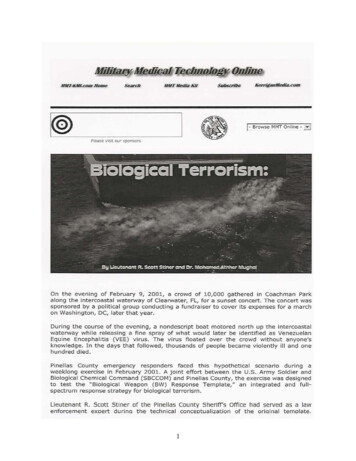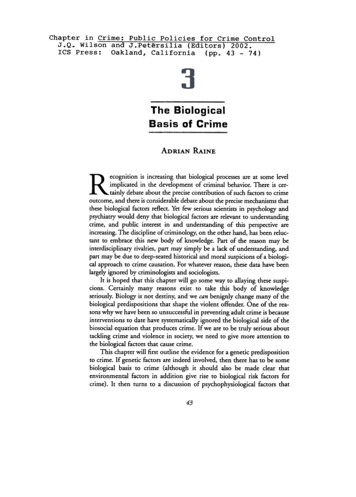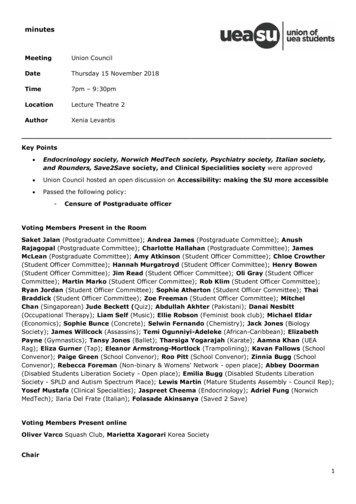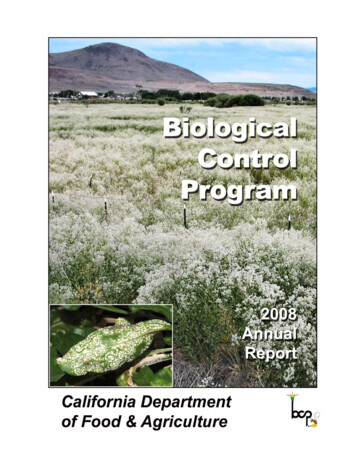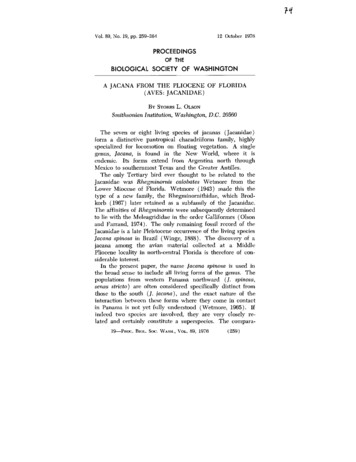
Transcription
MVol. 89, No. 19, pp. 259-26412 October 1976PROCEEDINGSOF THEBIOLOGICAL SOCIETY OF WASHINGTONA JACANA FROM THE PLIOCENE OF FLORIDA(AVES: JACANIDAE)L. OLSONSmithsonian Institution, Washington, D.C. 20560BY STOHHSThe seven or eight living species of jacanas (Jacanidae)form a distinctive pantropical charadriiform family, highlyspecialized for locomotion on floating vegetation. A singlegenus, Jacana, is found in the New World, where it isendemic. Its forms extend from Argentina north throughMexico to southernmost Texas and the Greater Antilles.The only Tertiary bird ever thought to be related to theJacanidae was Rhegminornis calohates Wetmore from theLower Miocene of Florida. Wetmore (1943) made this thetype of a new family, the Rhegminornithidae, which Brodkorb (1967) later retained as a subfamily of the Jacanidae.The affinities of Rhegminornis were subsequently determinedto lie with the Meleagrididae in the order Galliformes (Olsonand Farrand, 1974). The only remaining fossil record of theJacanidae is a late Pleistocene occurrence of the living speciesJacana spinosa in Brazil {Winge, 1888). The discovery of ajacana among the avian material collected at a MiddlePliocene locality in north-central Florida is therefore of considerable interest.In the present paper, the name Jacana spinosa is used inthe broad sense to include all living forms of the genus. Thepopulations from western Panama northward (/. spinosa,sensu stricto) are often considered specifically distinct fromthose to the south (/, jacana), and the exact nature of theinteraction between these forms where they come in contactin Panama is not yet fully understood (Wetmore, 1965). Ifindeed two species are involved, they are very closely related and certainly constitute a superspecies. The compara19 pROC, BIOL. Soc. WASH., VOL. 89, 1976(259)
260Proceedings of the Biological Society of WashingtonFIG. 1. Jacana farrandi, new species, stereo pairs of holotype lefttarsometatarsus UF 21219: a, anterior view; b, internal view; c, posteriorview. Twice natural size.tivc series of skeletons in this study consisted of 11 malesand 6 females of /. spinosa from Cuba, Hispaniola, Guatemala, Venezuela, Brazil, and Argentina, as well as specimens of Actophilornis africanus, Metopidius indicus, andHydrophasianus chirurgus.Jacana farrandi, new speciesFigures 1 and 2Holotype: Distal end of left tarsometatarsus lacking much of theouter trochlea, Florida State Museum UF 21219.Locality and horizon: "Rhino Hole," McGehee Farm, 3.6 milesnorth of Newberry, Alachua County, Florida. Collected by S. DavidWebb and field crew, April 1967. Alachua Formation, early Hemphillian land mammal stage, Middle Pliocene.Measurements of holotype: See Table 1.Paratype: Topotypieal left coracoid lacking part of the procoracoidand sterno-coracoidal processes, UF 11108. Collected 4 May 1965by S. David Webb, Robert Allen, and Jesse S. Robertson.Etymology: To my friend and sage counsellor in all matters ornithological, John Farrand, Jr., of the American Museum of NaturalHistory, in recognition of his interest in the Jacanidae.
Pliocene jacana from Florida261BFIG. 2. Jacana farrandi, new species, stereo pairs of paratype leftcoracoid UF 11108: a, ventral view; b, dorsal view; c, internal view.Twice natural size.Diagnosis and description: The holotype tarsometatarsus is immediately recognizable as that of a jacana by the extremely largedistal foramen and the very deep tendinal groove leading to it. Thetype of farrandi agrees with Jacana and differs from the other generaexamined in having a much deeper pit on the medial surface of theinternal trochlea.The tarsometatarsus of /. farrandi differs from that of /. spinosaas follows; middle trochlea decidedly longer, projecting farther beyond the internal trochlea and bearing a deeper median groove; inposterior view, area between distal foramen and inner trochlea notdeeply excavated as in the modern form; scar for hallux withoutprominent medial lip; tendinal groove wider and deeper; inner trochleaproportionately wider and deeper, lacking the distinct projection onthe proximal corner of the posterolateral surface seen in /. spinosa,and with posterior crest more prominent.The coracoid of J. farrandi differs from that of J. spniosa as follows: acrocoracoid rotated laterally so that it projects much fartherventrally; furcular facet much narrower with much less of an overhanging ossified lip; protuberance on dorsal surface of sternal end ofprocoracoid more prominent; neck not as excavated.Jacana farrandi is distinctly larger than J. spinosa (Table 1). Inthe Jacanidae there is marked sexual dimorphism in size, the femalesbeing much larger; in the series of /. spinosa used here, there wasvirtually no overlap in size beween the two sexes (Table 1). Theholotype tarsometatarsus of /. farrandi is larger than in any of theavailable specimens of /. spinosa and is probably from a female. Theparatype coracoid is smaller than in females of /. spinosa but larger
262TABLEProceedings of the Biological Society of Washington1. Measurements of Jacana spinosa (115 3, 69 9) comparedwith Jacana farrandi, new species.rangemeans.d.9Fossil5.8- 6.57.0- 7.57.86.37.20.230.18 9Fossil1.9- 2.22.2- 2.52.72.02.30.090.099Fossil2.6- 2.93.1- 3.53.72.73.30.100.14Distance from distalforamen to distaledge of middletrochlea39Fossil3.3- 3.73.6- 4.44.63.53.90.120.27Greatest length 560.68Distal width oftarsometatarsusWidth of middletrochleaDepth of middletrochlea than in males and is therefore probably from a male. Both specimens thus reflect the larger size of the fossil species.Remarks: Numerous other vertebrates have been found at the McGehee Farm site (Hirschfeld and Webb, 1968). The most intensivelystudied of these are tortoises (Auffenberg, 1966), edentates (Hirschfeldand Webb, 1968) and canids (Webb, 1969). Birds previously recorded from this locality include a cormorant Phalacrocorax wetmorei,a night heron Nycticorax fidem, and a sandpiper Ereunetes ( Calidrin) rayi (Brodkorb, 1963). Although Brodkorb's paper refers to theMcGehee deposits as being Lower Pliocene, Webb (1969:305) nowconsiders them to be of early Hemphillian (Middle Pliocene) age.It is difficult to envision a better paleoecological indicator than ajacana. By analogy with living forms, we may assume that the climatein Florida in early Hemphillian time was warm and tropical, probablythe year round since jacanas are not migratory. Furthermore, we canbe sure that when the remains of Jacana farrandi were deposited,not only was fresh water present, but abundant floating vegetation,probably including water lilies (Nymphaeaceae), as well, since allmodern jacanas require such a habitat.ACKNOWLEDGMENTSI am particularly endebted to S. David Webb and Pierce Brodkorb for allowing me to study the fossils and for their comments onthe manuscript. The photographs are by Victor E. Krantz.
Pliocene jacana from Florida263LITERATURE CITEDW. 1966. A new species of Pliocene tortoise, genusGeochelone, from Florida, Jour. Paleont. 40:877-882.BRODKORB, P.1963. Fossil birds from the Alachua Clay of Florida.Florida Geol. Surv. Spec. Publ. No. 2(4): 1-17. 1967. Catalogue of fossil birds: Part 3 (Ralliformes, Ichthyornithiformes, Cliaradriif onries). Bull. Florida State Mus.Biol. Sci. 11:99-220.HIRSCHFELD, S. E., AND S. D. WEBB.1968. Plio-Pleistocene megalonychid sloths of North America. Bull. Florida State Mus.Biol. Sci. 12:213-296.OLSON, S. L., AND J. FARRAND, JR.1974. Rhegminornis restudied:a tiny Miocene turkey. Wilson Bull. 86:114-120.WEBB, S. D.1969. The Pliocene Canidae of Florida. Bull. FloridaState Mus. Biol. Sci. 14:273-308.WETMORE, A.1943. Fossil birds from the Tertiary deposits ofFlorida. Proc. New England Zool. Club 22:59-68. 1965. Birds of the Republic of Panama. Part No. 1.—Tinamidae (Tinamous) to Rynchopidae (Skimmers). Smithsonian Misc. Publ. 150.WINCE, O.1888. Fugle fra Knoglehuler i Brasilien. E Museo Lundiil(2):l-54.AUFFENBERC,
264 Proceedings of the Biological Society of Washington
Gehee Farm site (Hirschfeld and Webb, 1968). The most intensively studied of these are tortoises (Auffenberg, 1966), edentates (Hirschfeld and Webb, 1968) and canids (Webb, 1969). Birds previously re- corded from this locality include a cormorant Phalacrocorax wetmorei, a night heron Nycticorax fidem, and a sandpiper Ereunetes ( Cali-



